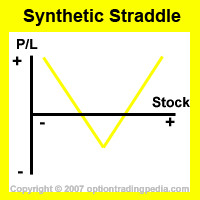What Are Synthetic Straddles in Options Trading?
Synthetic Straddle - Definition
A combination of stocks and call options which produces the same payoff characteristics as a Long Straddle options trading strategy.
What Is Synthetic Straddle?
Synthetic Straddle transforms a basic stock position into an options trading position that profits even when the stock goes down the same way that a long straddle options trading strategy does. This is useful when a stock you are holding is expected to move up or down strongly and you want to profit either way without having to sell your stocks. This is the kind of flexibility that options trading grants through the use of Synthetic Options Strategies.
|
|
When To Use Synthetic Straddle?
One should use a Synthetic Straddle when one's existing stock holding is expected to make a volatile move to either upside or downside strongly and wishes to profit from a move in either direction.
How To Use Synthetic Straddle?
There are 2 main ways to establish a Synthetic Straddle. One way is by buying twice as many At The Money (ATM) call options as you have short stocks , known as the Long Call Synthetic Straddle. The other way is by buying twice as many At The Money (ATM) put options as you have long stocks , known as the Long Put Synthetic Straddle.
Making Long Put Synthetic Straddle from Long StockExample : Assuming you own 100 shares of XYZ company trading at $40 now. To transform the position into Synthetic Straddle, you will buy 2 contracts (representing 200 shares) of XYZ's $40 put options. |
Making Long Call Synthetic Straddle from Short StockExample : Assuming you are short 100 shares of XYZ company trading at $40 now. To transform the position into Synthetic Straddle, you will buy 2 contracts (representing 200 shares) of XYZ's $40 call options. |
At this point, experienced options traders would notice that establishing a Synthetic Straddle actually creates a Delta Neutral Position.
Making Long Put Synthetic Straddle from Long StockExample : Assuming you own 100 shares of XYZ company trading at $40 now. To transform the position into Synthetic Straddle, you will buy 2 contracts (representing 200 shares) of XYZ's $40 put options. 100 shares = 100 delta. 200 ATM Put Options = -100 Delta (-0.5 delta each). Total Delta = 100 - 100 = 0 |
Making Long Call Synthetic Straddle from Short StockExample : Assuming you are short 100 shares of XYZ company trading at $40 now. To transform the position into Synthetic Straddle, you will buy 2 contracts (representing 200 shares) of XYZ's $40 call options. 100 short shares = -100 delta. 200 ATM Call Options = 100 Delta (0.5 delta each). |
Profit Potential Of Synthetic Straddle
Synthetic Straddle offers unlimited profit whether the stock moves upwards or downwards.
Risk / Reward Of Synthetic Straddle
Maximum Profit: Unlimited
Maximum Loss: Limited
(Limited to extrinsic value of options bought when stock remains stagnant)
Breakeven Point Of Synthetic Straddle
There are 2 break even points to a Synthetic Straddle. One breakeven point if the underlying asset goes up (Upper Breakeven), and one breakeven point if the underlying asset goes down (Lower Breakeven).
Lower Break Even = Option Strike Price - Extrinsic Value Of Options
Making Long Put Synthetic Straddle from Long StockExample : Assuming you own 100 shares of XYZ company trading at $40 now. To transform the position into Synthetic Straddle, you will buy 2 contracts (representing 200 shares) of XYZ's $40 put options at $1.50. Lower BreakEven = $40 - ($1.50 x 2) = $40 - $3 = $37 |
Advantage of Synthetic Straddle
Able to immediately transform a stock position into an options trading position which profits from either direction without closing the original stock position.

|
Don't Know If This Is The Right Option Strategy For You? Try our Option Strategy Selector! |
| Javascript Tree Menu |
Important Disclaimer : Options involve risk and are not suitable for all investors. Data and information is provided for informational purposes only, and is not intended for trading purposes. Neither www.optiontradingpedia.com, mastersoequity.com nor any of its data or content providers shall be liable for any errors, omissions, or delays in the content, or for any actions taken in reliance thereon. Data is deemed accurate but is not warranted or guaranteed. optiontradinpedia.com and mastersoequity.com are not a registered broker-dealer and does not endorse or recommend the services of any brokerage company. The brokerage company you select is solely responsible for its services to you. By accessing, viewing, or using this site in any way, you agree to be bound by the above conditions and disclaimers found on this site.
Copyright Warning : All contents and information presented here in www.optiontradingpedia.com are property of www.Optiontradingpedia.com and are not to be copied, redistributed or downloaded in any ways unless in accordance with our quoting policy. We have a comprehensive system to detect plagiarism and will take legal action against any individuals, websites or companies involved. We Take Our Copyright VERY Seriously!
Site Authored by
